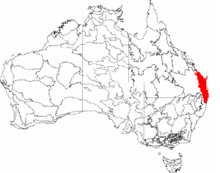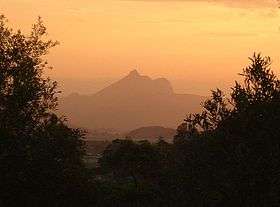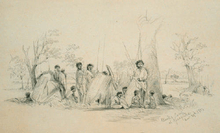Bundjalung people
| Bundjalung people | |
|---|---|
|
Aka: Badjalang (Tindale)(Horton) Bandjalang (SIL) | |
 South Eastern Queensland bioregion | |
| Hierarchy | |
| Language family: | Pama–Nyungan |
| Language branch: | Bandjalangic |
| Language group: | Bundjalung |
| Group dialects: | |
| Area (approx. 6,000 sq. km) | |
| Location: |
|
| Coordinates: | 29°15′S 152°55′E / 29.250°S 152.917°ECoordinates: 29°15′S 152°55′E / 29.250°S 152.917°E |
| Mountains: |
|
| Rivers[4] |
Lower reaches of
|
| Other geological: | Cape Byron |
| Urban areas:[4] | |
The Bundjalung people (also known as Bunjalung, Badjalang and Bandjalang) are Aboriginal Australians who are the original custodians of northern coastal areas of New South Wales (Australia), located approximately 550 kilometres (340 mi) northeast of Sydney, an area that includes the Bundjalung National Park and Mount Warning, known to the Bundjalung people as Wollumbin ("fighting chief of the mountains").[6]
Bundjalung people all share descent from ancestors who once spoke as their first, preferred language one or more of the dialects of the Bandjalang language.
The Arakwal of Byron Bay count themselves as one of the Bundjalung peoples.[7]
Language
Country
According to Norman Tindale, Bundjalung tribal lands encompassed roughly 2,300 square miles (6,000 km2), from the northern side of the Clarence River to the Richmond River, including Ballina with their inland extension running to Tabulam and Baryugil. The coastal Widje horde ventured no further than Rappville.[4]
Initiation ceremony
According to R. H. Mathews, the Bundjalung rite of transition into manhood began with a cleared space called a walloonggurra some distance from the main camp. On the evening the novices are taken from their mothers around dusk, the men sing their way to this bora ground where a small bullroarer (dhalguñgwn) is whirled.[8]
Religious beliefs
The Bundjalung people believe the spirits of wounded warriors are present within the mountains, their injuries having manifested themselves as scars on the mountainside, and thunderstorms in the mountains recall the sounds of those warriors' battles. Wollumbin itself is the site at which one of the chief warriors lies, and it is said his face can still be seen in the mountain's rocks when viewed from the north.[9]

Land claim
Descendants of two tribes within the modern Bundjalung federation, namely the Githabul and the Western Bundjalung people have had their native title rights recognized, respectively in 2007[10] and 2017.
Musical instruments
The Bundjalung used a variety of instruments including blowing on a eucalyptus leaf, creating a bird-like sound. Clapsticks were used to establish a drumbeat rhythm on ceremonial dancing occasions. Emu callers, short, one foot, about 30 cm long didgeridoos were traditionally used by the Bundjalung when hunting (Eastern Australia Coastal Emus). When striking the emu-caller at one end with the open palm it sounds like an emu. This decoy attracts the bird out of the bush making it an easy prey.
Notable people
Notable Bundjalung people include:luc holmes nrl player
- Bronwyn Bancroft (born 1958) is an Australian artist, notable for being amongst the first Australian fashion designers invited to show her work in Paris. Born in Tenterfield, New South Wales, and trained in Canberra and Sydney, Bancroft worked as a fashion designer, and is an artist, illustrator, and arts administrator.
- Troy Cassar-Daley – born at Grafton to an Aboriginal mother and a Maltese-Australian father.[11]
- Joyce Clague - political activist
- Ruby Langford Ginibi – author, lecturer in Aboriginal history, culture and politics, whose grandfather "Sam" Anderson, in a game of cricket in 1928 at Lismore, became one of only two Aboriginal cricketers to ever get Sir Donald Bradman out, for a duck.[12]
- Anthony Mundine – professional boxer and multiple-time world champion. He is also a former New South Wales State of Origin representative footballer who played for St. George Illawarra Dragons and Brisbane Broncos in the Australian NRL. Before his move to boxing he was the highest paid player in the NRL.
- Warren Mundine – an advisor to the current Prime Minister, former National President of the Australian Labor Party and also a Director of the Australian Indigenous Education Foundation.
- Mark Olive – also known as the "Black Olive" & "Bush food crusader", a Wollongong born chef who trained in Europe, with over twenty years cooking experience, and he has his own pay TV indigenous cooking show, The Outback Cafe and is also the author of cookbooks such as Olive's Outback Cafe: A Taste of Australia.
- Johnny Jarrett (Patten) – former Australian Bantamweight boxing champion (1958 - 1962).
- Wes Patten – actor, television host, and former NRL player with the South Sydney Rabbitohs, St.George Dragons, Balmain Tigers and Gold Coast Chargers. Roles in television and film include playing opposite Cate Blanchett in Heartland (1994) and Hugo Weaving in Dirt Water Dynasty (1988). Other roles include stints on A Country Practice, Wills & Burke, and G.P.
- Albert Torrens – a former international rugby league footballer who played for the Manly-Warringah Sea Eagles, Northern Eagles and St. George Illawarra Dragons in the Australian NRL and for the Huddersfield Giants in the European Super League.
Alternative names

- Badjelang. (paidjal/badjal means "man")
- Budulung
- Buggul
- Paikalyung, Paikalyug
- Bandjalang, Bandjalong
- Bunjellung
- Bundela, Bundel
- Widje. (clan or clans at Evans Head)
- Watchee
- Woomargou[4]
See also
Notes
Citations
- ↑ Bunjalung of Byron Bay (Arakwal) Indigenous Land.
- 1 2 3 4 5 6 7 Sharpe 1994.
- 1 2 Bandjalang at Ethnologue (20th ed., 2017)
- 1 2 3 4 5 Tindale 1974, p. 191.
- ↑ Bunjalung Jugun (Bunjalung Country), Jennifer Hoff, Richmond River Historical Society, 2006, ISBN 1-875474-24-2, citing Yamba Yesterday, Howland and Lee, Yamba Centenary Committee, 1985
- ↑ Steele 1984, pp. 51–52.
- ↑ Agreements.
- ↑ Mathews 1900, pp. 67–73,67.
- ↑ Steele 1984, pp. 52.
- ↑ NNTT 2007.
- ↑ ABC 2009.
- ↑ Langford Ginibi 1995, p. 4.
Sources
- "ATNS - Agreements, Treaties and Negotiated Settlements project". Agreements, Treaties and Negotiated Settlements (ATNS) project. Retrieved 14 May 2015.
- Bundock, M. (1889). "Note on the aborigines of Casino, N.S.W." Archiv für Ethnologie. 2: 52–53.
- "Bunjalung of Byron Bay (Arakwal) Indigenous Land Use Agreement". Agreements, Treaties and Negotiated Settlements (ATNS) project. Retrieved 20 May 2008.
- "Githabul People's native title determination: North-eastern New South Wales" (PDF). National Native Title Tribunal. 29 November 2007. Archived from the original (pdf) on 1 June 2011.
- Langford Ginibi, Ruby (15 November 1995). "Ruby Langford Ginibi: Full interview transcript" (Interview). Interviewed by Robin Hughes. Australian Biography project. pp. 1–5.
- Mathews, R. H. (1897a). "Totemic divisions of the Australian tribes". Proceedings of Royal Society of New South Wales. 31: 154–176.
- Mathews, R. H. (1897b). "Wandarral of the Richmond and Clarence River tribes". Proceedings of Royal Society of Victoria. 10: 29–42.
- Mathews, R. H. (1898). "Initiation ceremonies of Australian tribes. Appendix Nguttan initiation ceremony". Proceedings of the American Philosophical Society. 37: 54–73.
- Mathews, R. H. (1900). "Walloonggurra ceremony" (PDF). Queensland Geographic Journal. 15: 67–74.
- Sharpe, Margaret C. (1985). "Bundjalung Settlement and Migration" (PDF). Aboriginal History. 9 (1): 101–124.
- Sharpe, Margaret C. (1994). An all-dialect dictionary of Banjalang, an Australian language which is still in use
- Steele, John Gladstone (1984). Aboriginal Pathways: in Southeast Queensland and the Richmond River. University of Queensland Press. ISBN 978-0-702-25742-1.
- Threlkeld, Lancelot; Fraser, John (1892). An Australian language as spoken by the Awabakal (PDF). Sydney: Government printer.
- Tindale, Norman Barnett (1974). "Badjalang (QLD)". Aboriginal Tribes of Australia: Their Terrain, Environmental Controls, Distribution, Limits, and Proper Names. Australian National University Press.
- "Troy Cassar-Daley". Talking Heads. Australian Broadcasting Corporation. 4 May 2009. Retrieved 12 July 2011.
External links
- Badjalang portion of Norman Tindale's Aboriginal Tribes of Australia map Accessed 21 May 2008
- Bundjalung of Byron Bay Aboriginal Corporation, representing the Bundjalung and Arakwal people, land and waters
- Bibliography of Bundjalung language and people resources, at the Australian Institute of Aboriginal and Torres Strait Islander Studies
- Bibliography of Arakwal language and people resources, at the Australian Institute of Aboriginal and Torres Strait Islander Studies
- "Australia's Sacred Sites Part 5 - Byron Bay" ABC Radio's Spirit of Things (October 2002; Accessed 21 May 2008
- A Walk in the Park Series: "New South Wales - Arakwal National Park" ABC Radio (December 2004) Accessed 21 May 2008
- "Badjalang" AusAnthrop Australian Aboriginal tribal database. Accessed 20 May 2008
- Bunjalung of Byron Bay (Arakwal) Indigenous Land Use Agreement (ILUA) Accessed 21 May 2008
- New South Wales Department of Environment and Climate Change Aboriginal cultural heritage webpage Living on the frontier Accessed 21 May 2008
- New South Wales Department of Environment and Climate Change November 2007 Media Release Wollumbin Aboriginal Consultative Group Accessed 21 May 2008